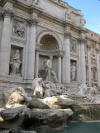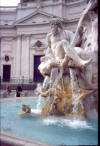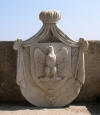

St. Peter's,
Rome
"Pope Paul V (r. 1605 - 1621)... commissioned [Carlo] Maderno in
1606 to complete Saint Peter's in Rome. As the symbolic
seat of the papacy, Saint Peter's radiated enormous
symbolic presence. In light of the lingering
Counter-Reformation concerns, the desire of Baroque popes to
conclude the extended rebuilding project and reestablish the
force embodied in the mammoth structure is understandable. ...
The preexisting core of an incomplete building restricted
Maderno, so he did not have the luxury of formulating a totally
new concept for Saint Peter's. Maderno's plan for
Saint Peter's ... departed from the central plans designed for
it by Bramante and, later,
Michelangelo."
- Gardner's
Art Through The Ages,
11th edition, Vol. II, p. 723

view from the
roof of St. Peter's, Rome
"The design of Saint Peter's finally was completed (except for
details) by Gianlorenzo Bernini (1598 - 1680). Bernini was
an architect, a painter, and a sculptor - one of the most
important and imaginative artists of the Italian Baroque era and
its most characteristic and sustaining spirit. Bernini's
largest and most impressive single project was the design for a
monumental piazza (plaza; 1656 - 1667) in front of Saint
Peter's. ... Bernini had to adjust his design to some
preexisting structures on the site - an ancient obelisk the
Romans had brought
from Egypt
(which Pope Sixtus had relocated to the piazza in 1585 as a part
of his vision of Christian triumph in Rome) and a fountain
Maderno designed. He used these features to define the
long axis of a vast oval embraced by colonnades joined to the
Saint Peter's facade by two diverging wings. Four rows of
huge Tuscan columns make up two colonnades, which terminate in
severely Classical temple fonts. The dramatic gesture of
embrace the colonnades make as viewers enter the piazza
symbolizes the welcome the Roman Catholic Church gave its
members during the Counter-Reformation. Bernini himself
referred to his design of the colonnade as appearing like the
welcoming arms of the church.... By its sheer scale and
theatricality, the complete Saint Peter's fulfilled
Catholicism's needs in the seventeenth century by presenting an
awe-inspiring and authoritative vision of the Church."
- Gardner's
Art Through The Ages,
11th edition, Vol. II, pp. 723 - 724
Trevi Fountain, Rome
 and another view:
and another view:

The use of
decorative gardens and fanciful and elaborate fountains was also
typical of the Italian Baroque. Various estates and city
plazas in Rome, for example, testify to this Baroque fashion for
highly ornate and creatively sculpted fountains.

Fountain of the
Four Rivers, Rome
Napoleon's Crest from his Villa on the Isle of
Elba:

|